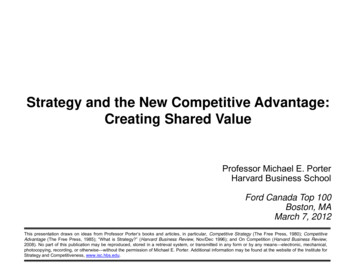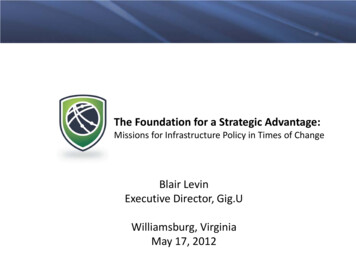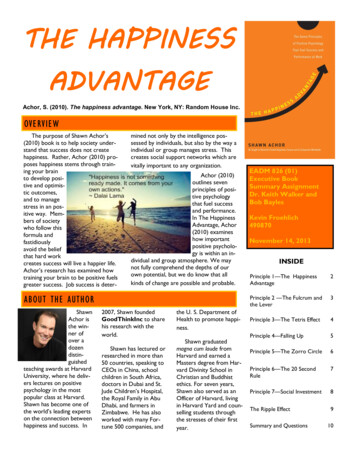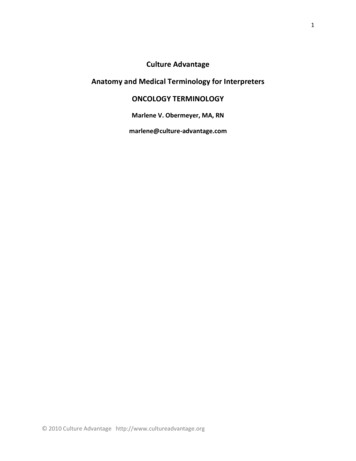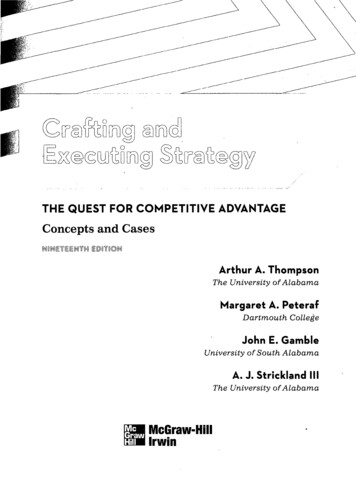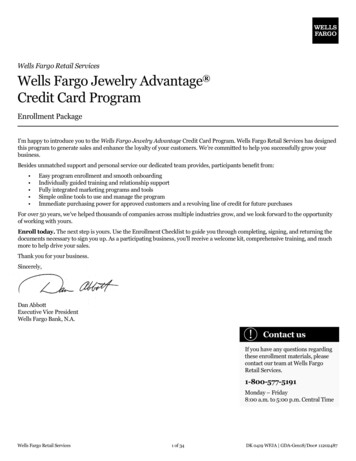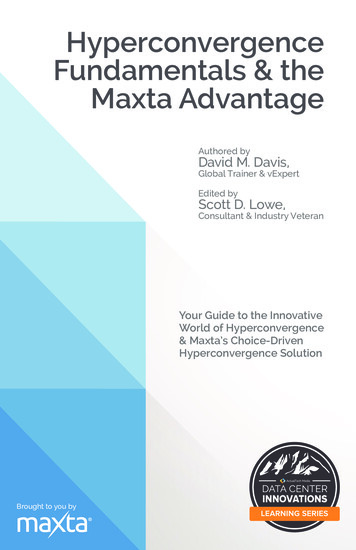
Transcription
HyperconvergenceFundamentals & theMaxta AdvantageAuthored byDavid M. Davis,Global Trainer & vExpertEdited byScott D. Lowe,Consultant & Industry VeteranYour Guide to the InnovativeWorld of Hyperconvergence& Maxta’s Choice-DrivenHyperconvergence SolutionBrought to you byINNOVATIONS
DATA CENTER INNOVATIONS LEARNING SERIESHyperconvergenceFundamentals & theMaxta AdvantageAuthored byDavid M. Davis,Global Trainer & vExpert Edited byScott D. Lowe,Consultant & Industry Veteran
Data Center Innovations Learning Series HyperconvergenceFundamentals & the Maxta AdvantageAuthor:Editors:David M. Davis, ActualTech MediaScott D. Lowe, ActualTech MediaHilary Kerchner, Dream Write CreativeKiran Sreenivasamurthy, MaxtaBook Design:Braeden Black, Avalon Media ProductionsGeordie Carswell, ActualTech MediaLayout:Braeden Black, Avalon Media ProductionsCopyright 2015 by ActualTech MediaAll rights reserved. This book or any portion there of may not be reproduced or usedin any manner whatsoever without the express written permission of the publisherexcept for the use of brief quotations in a book review.Printed in the United States of AmericaFirst Printing, 2015ISBN 978-1-943952-01-4ActualTech MediaOkatie Village Ste 103-157Bluffton, SC 29909www.actualtechmedia.com
ForewordHyperconverged infrastructure is a data center architecture that has all ofthe makings of a revolutionary advancement in how IT provides this business-critical environment. From the promises of lower costs, easier growthand scalability, massively simplified administration, and even the completeelimination of the expensive, complex and monolithic SAN, hyperconvergedinfrastructure appears to touch on almost all of modern IT’s pain points.However, as in all things that seem too good to be true, the devil in in thedetails. Different hyperconverged infrastructure vendors provide vastlydissimilar solutions that don’t always meet customer expectations. It takessome effort and open, honest, and transparent communication from vendorsand industry analysts to help you understand the reality behind solutions.ActualTech Media’s mission is to help consumers understand this reality. Weshine the light on today’s data center innovations in a way that is positive andaccessible. To assist in this learning process, we have developed a brand newprogram to shine light on the underpinnings beneath these new technologyapproaches: Data Center Innovations.In this book, the very first in the series, we are thrilled to have Maxta as theinaugural solution. You will learn about the real reasons that hyperconvergedinfrastructure is taking the data center market by storm. You will also learnabout how Maxta’s innovations specifically address the most serious datacenter pain points and the unique benefits that Maxta brings to thehyperconverged infrastructure space.Scott D. LoweCo-founderActualTech Media
Table of ContentsSection 1: Hyperconvergence FundamentalsChapter 1: Introduction to Hyperconvergence3Chapter 2: Solving the IT Lifecycle Problem withHyperconvergence7Chapter 3: Simplifying the Data Center withHyperconverged Infrastructure13Chapter 4: Data Protection in the Worldof Hyperconvergence21Chapter 5: Data Reduction and Hyperconvergence29Chapter 6: Agility, Availability, & Hyperconvergence31Section 2: The Maxta AdvantageChapter 7: Who Is Maxta?39Chapter 8: Delivering Day One Results45Chapter 9: Independent Resource Scaling49Chapter 10: A Question of Form (Factor)53Chapter 11: Hyperconvergence Pricing and Budgeting59
About the AuthorDavid M. Davis,Global Trainer & vExpertDavid Davis is a partner and co-founder ofActualTech Media. With over 20 years inenterprise technology, he has served as anIT Manager and has authored hundreds ofpapers, ebooks, and video training courses.He’s a 6 x vExpert, VCP, VCAP, & CCIE#9369. You’ll find his vSphere video trainingat www.Pluralsight.com and he blogs atwww.VirtualizationSoftware.com andwww.ActualTech.io.About the EditorScott D. Lowe,Consultant & Industry VeteranScott Lowe is a vExpert and partner andCo-Founder of ActualTech Media. Scott hasbeen in the IT field for close to twenty yearsand spent ten of those years in filling the CIOrole for various organizations. Scott has written thousands of articles and blog postingsand regularly contributes towww.EnterpriseStorageGuide.com &www.ActualTech.io.
About ActualTech MediaActualTech Media provides enterprise IT decision makers with theinformation they need to make informed, strategic decisions as theymodernize and optimize their IT operations.Leading 3rd party IT industry influencers Scott D. Lowe, David M.Davis and special technical partners cover hot topics from the software-defined data center to hyperconvergence and virtualization.Cutting through the hype, noise and claims around new data centertechnologies isn’t easy, but ActualTech Media helps find the signal inthe noise. Analysis, authorship and events produced by ActualTechMedia provide an essential piece of the technology evaluation puzzle.More information available at www.actualtechmedia.com
Maximize the Promise of Hyper-convergenceMaxta’s hyperconverged solutions dramatically simplify IT, deliverenterprise-class data services and hyper-scale while enabling significantcost savings.Maximize Flexibility Any server Any hypervisor Any storage device Any workloadMaximize Simplicity VM centric Data Agility MaxDeploy MxSP Any ServerMaximize Savings Industry StandardComponents Simplified Management Storage EfficiencyVisit www.Maxta.com
Book FeaturesReal WorldHow a technical point can impact the real world of IT.In DepthTakes readers into the deep, dark depths of a particular topic.IntroductionIt may come as no surprise that technology in the data center is advancing at break-neck pace. However, what you may not realize is that thereis a relatively new option for the data center called hyperconvergence.Whether your data center is a few servers under the desk or a fewthousand servers in a massive enterprise data center, hyperconvergencehas the potential to make massive improvements in efficiency, simplicity, agility, availability, and data protection — all while saving yourcompany real money. It accomplishes this by using virtualization tointegrate compute and storage resources into an innovative, completesolution.Hyperconvergence is unique. Unlike other new enterprise technologythat improves performance or capacity in a single area, hyperconvergence offers a wide breadth of benefits in multiple infrastructure andbusiness areas, such as the extending the IT lifecycle.
The term hyperconvergence can be confusing because it is thrownaround by different vendors doing very different things. Thus, it’simportant to not only understand the multiple ways that hyperconvergence helps the infrastructure group and the business, but also howit really does what it does. In other words, you need to know howhyperconvergence truly works.For that reason, we’ll cover the fundamentals of hyperconvergencetechnology in the first half of this book. In the fundamentals sectionof the book, we’ll explore how hyperconvergence helps the IT lifecycle,simplifies the data center, provides data protection improvements,reduces data storage demands, and improves application availabilityand business agility.In the second section of the book, we’ll cover a specific hyperconvergence technology – the Maxta storage platform, or MxSP. We’ll findout how companies are using Maxta to implement hyperconvergence,scale resources independently, better protect their data, and quickly seeimprovements in efficiency.As mentioned previously, don’t look at hyperconvergence as justoffering improvements in a single area of the data center or the business — it is so much more. Read on to learn how hyperconvergenceprovides a whole new way to think about your data center technology.
Section 1HyperconvergenceFundamentals
1Introduction toHyperconvergenceIt’s been called Server SAN, Hyperconvergence, Hyper-Convergence,Hyperconverged Infrastructure (HCI), and software-defined storage but what truly is hyperconvergence? How did it develop?Hyperconvergence HistoryIn the past, applications ran best when they were given their ownphysical server and own LUN on the SAN for storage. We IT professionals wanted to make the business and application owners happyby providing applications with everything they needed and simplifyadministration.Then along came server virtualization, and we consolidated as many ofour physical servers as we could justify. Server virtualization providedamazing efficiency across so many areas that it actually ended upkicking off today’s hyperconvergence revolution. This is because, as thenumber of virtualized servers grew, it became apparent that the storageinfrastructure did not offer the performance required, the utilization ofthat storage infrastructure was inefficient, and the management of thestorage infrastructure was much more painful than it needed to be.
Since that point, many vendors stepped forward to offer storagesolutions for the problems triggered by server virtualization. The mostcomprehensive and most efficient of those solutions to-date hyperconvergence.Hyperconvergence DefinedIt’s obvious that the -convergence part of the word hyperconvergencemeans to “bring together.” However, the word part hyper- eithermeans “energetic,” or “hypervisor,” or both.Convergence in the data center first became popular for combiningservers and storage into a single offering when VMware Cisco andEMC formed VCE and began offering the converged Vblock solution.However, the vast majority of companies require a much moreaffordable, flexible, and granular convergence solution. This is wherehyperconvergence comes in.Hyperconvergence leverages the increasing computing powerof x86 servers, layers both server and storage virtualization byintegrating compute and storage, and offers greater efficiencythan was available from siloed infrastructure resources inthe past.The term hyperconvergence is attributed to blogger and technologist,Steve Chambers, who in 2012 said that hyperconvergence was anextension of the overall convergence trend, collapsing the data centerinto an appliance form factor.Some companies define hyperconvergence simply as “a solution that,using virtualization, brings the computer layer and storage layerIntroduction to Hyperconvergence3
together.” You should be aware that hyperconvergence today is muchmore than that. Yes, hyperconvergence uses virtualization and bringstogether compute and storage resources in the data center; however,hyperconvergence also should integrate those resources into a completesolution that is much easier to manage, support, and scale. Additionally, true hyperconvergence should offer enterprises additionalfunctionality from the integrated solution over what they had before,such as data reduction, data protection, increased availability, andgreater business agility.The Hyperconverged InfrastructureVMVMVSAVMVMVSAVMVMVSADistributed Storage verFigure 1-1: Hyperconverged InfrastructureAs you see in Figure 1-1, a hyperconverged infrastructure, or HCI,is typically comprised of multiple servers running a virtualizationhypervisor and distributed storage layer, offering high-availability forcompute and storage, ease of scale for both types of resources, and asimplified management console.Keep in mind that not all hyperconverged infrastructures are createdequally. You will want to make sure that your hyperconvergence4Chapter 1
solution doesn’t just join the resources together, but also does so in away that provides real business value and additional functionality.The Future of HyperconvergenceHyperconvergence is a fast-moving target. It’s an area of enterprisetechnology that is developing rapidly. The hyperconvergence solutionsof today are quickly changing the way enterprise data centers function,the way they are managed, and how they are planned and paid for.Plus, if the current trends are any indication, hyperconvergence willbring greater and greater value to enterprises by offering more integrated functionality and advanced features. For example, when yourcompany’s data is stored in an HCI, that data could be easily deduplicated to reduce storage capacity demands and also easily replicated to apublic cloud or another data center for protection. Additionally, futurehyperconvergence solutions will bring together not only compute andstorage resources but also network resources to create the ultimatehyperconverged data center with the most flexibility and efficiency.Up NextAre you overburdened with with the continuous refresh and complexity of your IT infrastructure? There is an answer. Read on to find outhow hyperconvergence can help.Introduction to Hyperconvergence5
2Solving the ITLifecycleProblem withHyperconvergenceHyperconvergence benefits companies in many ways, one of which isby improving the IT lifecycle. What is the “IT lifecycle”? And why is itso important?The IT lifecycle, or ITLC, dictates the life of an IT service, fromplanning and optimizing the service to aligning the service with thebusiness strategy. The ITLC outlines the service design and deliveryas well as its ongoing operation and support. It’s important becausemanagement of the ITLC is a constant in the enterprise, requiring adedicated investment of time and money.While the ITLC should always be aligned with the needs of the business and its critical applications, at too many companies, many aspectsof the ITLC have become huge expenses that are disproportional to thedemands of the business.
The IT lifecycle, or ITLC, manages the life of an IT service.Examples of IT services where the ITLC applies are desktopcomputers, applications, or virtual machines. In the case ofhyperconvergence, we are discussing the ITLC related todatacenter servers and storage.The ITLC is broken down into the procurement, deplo
DATA CENTER INNOVATIONS LEARNING SERIES. Data Center Innovations Learning Series Hyperconvergence Fundamentals & the Maxta Advantage Author: David M. Davis, ActualTech Media Editors: Scott D. Lowe, ActualTech Media Hilary Kerchner, Dream Write Creative Kiran Sreenivasamurthy, Maxta Book Design: Braeden Black, Avalon Media Productions Geordie Carswell,



